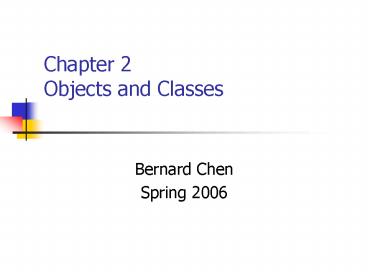Chapter 2 Objects and Classes - PowerPoint PPT Presentation
1 / 16
Title:
Chapter 2 Objects and Classes
Description:
Chapter 2 Objects and Classes Bernard Chen Spring 2006 2.1 What is OO programming? Object: an atomic unit that has structure and state Information hiding: Black-box ... – PowerPoint PPT presentation
Number of Views:115
Avg rating:3.0/5.0
Title: Chapter 2 Objects and Classes
1
Chapter 2Objects and Classes
- Bernard Chen
- Spring 2006
2
2.1 What is OO programming?
- Object an atomic unit that has structure and
state - Information hiding Black-box analogy
- Encapsulation grouping of data and functions
- Inheritance mechanism allows extending
functionality of an object.
3
How does C support OO
- Template the logic is independent of
- the type
- Inheritance
- Polymorphism allows us to implement
- new types (classes) that
- share same logic
4
2.2 Basic Class Syntax
- Class members either data or functions and
categorized into either public, protected,or
private. - Public visible to an instance of (object) a
class - Private visible only inside an instance of a
class - Protected similar to private but visible to
derived classes. - Default all members are private
5
Constructors
- Member functions that describe how an object is
declared and initialized. - If no constructor defined, compilers will
generate one called default constructor. - Explicit constructors prevent automatic type
conversion.
6
Constant Member Function
- Constant functions (accessors) functions that
do not change any data member. - const is a part of the function signature.
const return_type name(const parameter_list)
const - Interface describes what can be done to the
object, i.e. the header. - Implementation represents internal processes
specified by the interface.
7
(No Transcript)
8
Big three Destructor, Copy Constructor, and
Operator
- Destructor tells how an object is destroyed and
freesdresources when it exists scope. - IntCell()
- Copy Constructor allows a new object construct
using the data in an existing one. - IntCella(5) // a new IntCellcall a
- IntCellb(a) // another IntCellcall b
- Operator copy assignment, copies data members
using by default.gt may cause shallow copying.
9
This (predefine pointer)
10
2.3 Additional C Features
- Operator overloading extending the types to
which an operator can be applied. - example string xMarys score is
- int y95
- string zxy
- ., ., ?, sizeof cant be overloaded
11
Additional C Features
- Type conversion creates a temporary object of a
new type - Example int a 5
- double b a //implicit cast
12
2.5 Exceptions (report error)
- An object that stores information transmitted
outside the normal return sequence and is used to
signal exceptional occurrences - Handle exceptions by throw and catch clauses.
13
Exceptions example
- try
- for (intn0 nlt10 n)
- if (ngt9) throw "Out of range"
- catch (char str)
- coutltlt "Exception " ltlt strltlt endl
14
2.6 String Class
- C string array of character terminated by \0
- C standard string a STL class with all
overload operators and built-in functions - http//www.bgsu.edu/departments/compsci/docs/strin
g.html
15
(No Transcript)
16
Summary
- Construction/ destruction of objects
- Copy semantics
- Overloading
- Implicit/explicit type conversion
- Information hiding/atomicity































